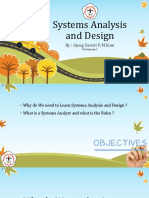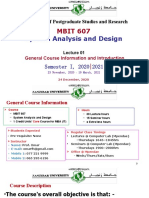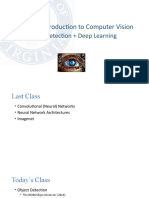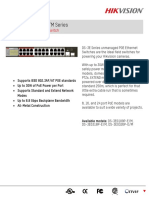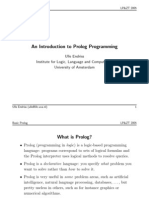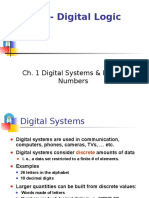Assuming The Role of The Systems Analyst: Systems Analysis and Design Kendall & Kendall Sixth Edition
Assuming The Role of The Systems Analyst: Systems Analysis and Design Kendall & Kendall Sixth Edition
Uploaded by
bidkar23Copyright:
Available Formats
Assuming The Role of The Systems Analyst: Systems Analysis and Design Kendall & Kendall Sixth Edition
Assuming The Role of The Systems Analyst: Systems Analysis and Design Kendall & Kendall Sixth Edition
Uploaded by
bidkar23Original Description:
Original Title
Copyright
Available Formats
Share this document
Did you find this document useful?
Is this content inappropriate?
Report this DocumentCopyright:
Available Formats
Assuming The Role of The Systems Analyst: Systems Analysis and Design Kendall & Kendall Sixth Edition
Assuming The Role of The Systems Analyst: Systems Analysis and Design Kendall & Kendall Sixth Edition
Uploaded by
bidkar23Copyright:
Available Formats
Chapter 1
Assuming the Role of the
Systems Analyst
Systems Analysis and Design
Kendall & Kendall
Sixth Edition
Major Topics
• Information systems
• Phases of analysis and design
• System maintenance
• CASE tools
• Alternate methodologies
Kendall & Kendall 2005 Pearson Prentice Hall 1-2
Information
• Information is an organizational
resource, which must be managed as
carefully as other resources.
• Costs are associated with information
processing.
• Information processing must be
managed to take full advantage of its
potential.
Kendall & Kendall 2005 Pearson Prentice Hall 1-3
Categories
Information systems fall into one of the
following eight categories:
• Transaction processing systems (TPS).
• Office automation systems (OAS).
• Knowledge work systems (KWS).
• Management information systems (MIS).
• Decision support systems (DSS).
• Expert systems (ES) and Artificial Intelligence (AI).
• Group decision support systems (GDSS) and Computer-
Supported Collaborative Work Systems.
• Executive support systems (EES).
Kendall & Kendall 2005 Pearson Prentice Hall 1-4
New Technologies
New technologies are being integrated
into traditional systems:
• Ecommerce uses the Web to perform business
activities.
• Enterprise Resource Planning (ERP) has the
goal of integrating many different information
systems within the corporation.
• Wireless and handheld devices, including
mobile commerce (mcommerce).
• Open source software.
Kendall & Kendall 2005 Pearson Prentice Hall 1-5
Kendall & Kendall 2005 Pearson Prentice Hall 1-6
Advantages of Using the Web
• The benefits of using the Web are:
• Increasing awareness of the availability
of the service, product, industry,
person, or group.
• 24-hour access for users.
• Standard interface design.
• Creating a global system.
Kendall & Kendall 2005 Pearson Prentice Hall 1-7
Nature of Analysis and Design
Systems analysis and design is a
systematic approach to:
• Identifying problems, opportunities, and
objectives.
• Analyzing the information flows in
organizations.
• Designing computerized information
systems to solve a problem.
Kendall & Kendall 2005 Pearson Prentice Hall 1-8
Systems Analyst
• Systems analysts act as:
• Outside consultants to businesses.
• Supporting experts within a business.
• As change agents.
• Analysts are problem solvers, and
require communication skills.
• Analysts must be ethical with users and
customers.
Kendall & Kendall 2005 Pearson Prentice Hall 1-9
Systems Development Life
Cycle
• The systems development life cycle is a
systematic approach to solving business
problems.
• It is divided into seven phases.
• Each phase has unique activities.
Kendall & Kendall 2005 Pearson Prentice Hall 1-10
Kendall & Kendall 2005 Pearson Prentice Hall 1-11
Phase 1
• Identifying:
• Problems.
• Opportunities.
• Objectives.
• Personnel involved:
• Analyst.
• User management.
• Systems management.
Kendall & Kendall 2005 Pearson Prentice Hall 1-12
Phase 2
• Determining information requirements:
• Interview management, operations personnel.
• Gather systems/operating documents.
• Use questionnaires.
• Observe the system and personnel involved.
• Learn the who, what, where, when, and how,
and the why for each of these.
Kendall & Kendall 2005 Pearson Prentice Hall 1-13
Phase 2 (Continued)
• Personnel involved:
• Analyst.
• User management.
• User operations workers.
• Systems management.
Kendall & Kendall 2005 Pearson Prentice Hall 1-14
Phase 3
• Analyzing system needs:
• Create data flow diagrams.
• Document procedural logic for data flow diagram
processes.
• Complete the data dictionary.
• Make semistructured decisions.
• Prepare and present the system proposal.
• Recommend the optimal solution to management.
Kendall & Kendall 2005 Pearson Prentice Hall 1-15
Phase 3 (Continued)
• Personnel involved:
• Analyst.
• User management.
• Systems management.
Kendall & Kendall 2005 Pearson Prentice Hall 1-16
Phase 4
• Designing the recommended system:
• Design the user interface.
• Design output.
• Design input.
• Design system controls.
• Design files and/or database.
• Produce program specifications.
• Produce decision trees or tables.
Kendall & Kendall 2005 Pearson Prentice Hall 1-17
Phase 4 (Continued)
• Personnel involved:
• Analyst.
• System designer.
• User management.
• User operations workers.
• Systems management.
Kendall & Kendall 2005 Pearson Prentice Hall 1-18
Phase 5
• Developing and documenting software:
• Design computer programs using structure
charts, Nassi-Schneiderman charts, and
pseudocode.
• Walkthrough program design.
• Write computer programs.
• Document software with help files,
procedure manuals, and Web sites with
Frequently Asked Questions.
Kendall & Kendall 2005 Pearson Prentice Hall 1-19
Phase 5 (Continued)
• Personnel involved:
• Analyst.
• System designer.
• Programmers.
• Systems management.
Kendall & Kendall 2005 Pearson Prentice Hall 1-20
Phase 6
• Testing and maintaining the system:
• Test and debug computer programs.
• Test the computer system.
• Enhance system.
Kendall & Kendall 2005 Pearson Prentice Hall 1-21
Phase 6 (Continued)
• Personnel involved:
• Analyst.
• System designer.
• Programmers.
• Systems management.
Kendall & Kendall 2005 Pearson Prentice Hall 1-22
Phase 7
• Implementing and evaluating the
system:
• Plan conversion.
• Train users.
• Purchase and install new equipment.
• Convert files.
• Install system.
• Review and evaluate system.
Kendall & Kendall 2005 Pearson Prentice Hall 1-23
Phase 7 (Continued)
• Personnel involved:
• Analyst.
• System designer.
• Programmers.
• User management.
• User operations workers.
• Systems management.
Kendall & Kendall 2005 Pearson Prentice Hall 1-24
Rapid Application Development
Rapid Application development (RAD) is
an object-oriented approach to systems
development.
Kendall & Kendall 2005 Pearson Prentice Hall 1-25
System Maintenance
• System maintenance is:
• Removing undetected errors, and
• Enhancing existing software.
• Time spent on maintenance typically
ranges from 48-60 percent of total
time.
Kendall & Kendall 2005 Pearson Prentice Hall 1-26
Kendall & Kendall 2005 Pearson Prentice Hall 1-27
System Enhancements
Systems are enhanced for the following
reasons:
• Adding additional features to the system.
• Business and governmental requirements
change over time.
• Technology, hardware, and software are
rapidly changing.
Kendall & Kendall 2005 Pearson Prentice Hall 1-28
Kendall & Kendall 2005 Pearson Prentice Hall 1-29
CASE Tools
• CASE tools are automated, microcomputer-
based software packages for systems
analysis and design.
• Four reasons for using CASE tools are:
• To increase analyst productivity.
• Facilitate communication among analysts and
users.
• Providing continuity between life cycle phases.
• To assess the impact of maintenance.
Kendall & Kendall 2005 Pearson Prentice Hall 1-30
CASE Tool Categories
CASE tools may be divided into several
categories
• Upper CASE (also called front-end CASE)
tools, used to perform analysis and design.
• Lower CASE (also called back-end CASE).
These tools generate computer language
source code from CASE design.
• Integrated CASE, performing both upper
and lower CASE functions.
Kendall & Kendall 2005 Pearson Prentice Hall 1-31
Upper CASE
Upper CASE tools:
• Create and modify the system design.
• Store data in a project repository.
• The repository is a collection of records,
elements, diagrams, screens, reports, and
other project information.
• These CASE tools model organizational
requirements and define system
boundaries.
Kendall & Kendall 2005 Pearson Prentice Hall 1-32
Lower CASE
• Lower CASE tools generate computer
source code from the CASE design.
• Source code may usually be generated
in several languages.
Kendall & Kendall 2005 Pearson Prentice Hall 1-33
Advantages of Generating
Code
• Time to develop new systems decreases.
• The time to maintain generated code is less than
to maintain traditional systems.
• Computer programs may be generated in more
than one language.
• CASE design may be purchased from third-party
vendors and tailored to organizational needs.
• Generated code is free from program coding
errors.
Kendall & Kendall 2005 Pearson Prentice Hall 1-34
Kendall & Kendall 2005 Pearson Prentice Hall 1-35
Reverse Engineering
• Reverse engineering is generating the
CASE design from computer program
code.
• Source code is examined, analyzed, and
converted into repository entities.
Kendall & Kendall 2005 Pearson Prentice Hall 1-36
Reverse Engineering
(Continued)
• Reverse engineering produces
(depending on the tool set used):
• Data structures and elements, describing
the files, records, and field.
• Screen designs, if the program is online.
• Report layouts for batch programs.
• A structure chart showing the hierarchy of
the modules in the program.
• Database design and relationships.
Kendall & Kendall 2005 Pearson Prentice Hall 1-37
Advantages of Reverse
Engineering
Reverse Engineering has the following
advantages:
• Reduced system maintenance time.
• Program documentation is produced for loosely
documented programs.
• Structured programs may be generated from
unstructured, older programs.
• Future system maintenance is easier to
implement.
• Unused portions of programs may be eliminated.
Kendall & Kendall 2005 Pearson Prentice Hall 1-38
Object-Oriented Analysis and
Design
• Object-oriented (O-O) analysis and
design is used to build object-oriented
programs.
• O-O programming examines the objects
of a system.
• Objects are grouped into classes for
optimal reuse and maintainability.
Kendall & Kendall 2005 Pearson Prentice Hall 1-39
The Unified Modeling
Language
• The Unified Modeling Language (UML)
is an industry standard for modeling
object-oriented systems.
• It breaks down a system into a use case
model.
Kendall & Kendall 2005 Pearson Prentice Hall 1-40
Extreme Programming (XP)
• Extreme programming takes good
software development practices and
pushes them to the limit.
• It is based on:
• Values.
• Principles.
• Core practices.
Kendall & Kendall 2005 Pearson Prentice Hall 1-41
Extreme Programming (XP)
(Continued)
• Extreme programming values are:
• Communication.
• Simplicity.
• Feedback.
• Courage.
Kendall & Kendall 2005 Pearson Prentice Hall 1-42
Alternate Methodologies
• Alternate methodologies are available
for analyzing systems.
• These include:
• Prototyping.
• ETHICS.
• Project Champions.
• Soft Systems Methodology.
• Multi-view.
Kendall & Kendall 2005 Pearson Prentice Hall 1-43
You might also like
- System Analysis and DesignDocument220 pagesSystem Analysis and DesignAbdulaziz HbllolNo ratings yet
- SAD-1to8Document294 pagesSAD-1to8Saurabh SharmaNo ratings yet
- Kendall SAD6 Ch01Document53 pagesKendall SAD6 Ch01alvin salesNo ratings yet
- Textbook: System Analysis & DesignDocument48 pagesTextbook: System Analysis & DesignirinamarcillaNo ratings yet
- Systems, Roles, and Development MethodologiesDocument50 pagesSystems, Roles, and Development MethodologiesrinaNo ratings yet
- The Systems Analyst: Prepared By: Engr. Joy N. Sadol College of Engineering and TechnologyDocument55 pagesThe Systems Analyst: Prepared By: Engr. Joy N. Sadol College of Engineering and TechnologyJhann Essa NadiaNo ratings yet
- Information System Development Methodology: Instructor: Hendrik Course: Sistem InformasiDocument39 pagesInformation System Development Methodology: Instructor: Hendrik Course: Sistem InformasiNaufal MubarakNo ratings yet
- Kendall Sad9 PP 01Document50 pagesKendall Sad9 PP 01SelvyMettaNo ratings yet
- Systems, Roles, and Development MethodologiesDocument50 pagesSystems, Roles, and Development MethodologiesPearl DescuatanNo ratings yet
- Systems Analysis and Design Kendall & Kendall Sixth EditionDocument32 pagesSystems Analysis and Design Kendall & Kendall Sixth EditionKen Keiro CayananNo ratings yet
- Assuming The Role of The Systems Analyst: Systems Analysis and Design, 7e Kendall & KendallDocument42 pagesAssuming The Role of The Systems Analyst: Systems Analysis and Design, 7e Kendall & KendallHoang Long DinhNo ratings yet
- IS-244 Unit-1 (Ch-01) PDFDocument33 pagesIS-244 Unit-1 (Ch-01) PDFAbrar Al-OtaibiNo ratings yet
- Assuming The Role of The Systems Analyst: Systems Analysis and Design Kendall and Kendall Fifth EditionDocument37 pagesAssuming The Role of The Systems Analyst: Systems Analysis and Design Kendall and Kendall Fifth EditionAnu MohanNo ratings yet
- Assuming The Role of The Systems Analyst: Information System Analysis and Design Dr. Patrick D. Cerna MSC AICM ProgramDocument38 pagesAssuming The Role of The Systems Analyst: Information System Analysis and Design Dr. Patrick D. Cerna MSC AICM ProgramPatcernaNo ratings yet
- SlidetDocument807 pagesSlidetEdli KominoNo ratings yet
- Systems, Roles, and Development MethodologiesDocument50 pagesSystems, Roles, and Development MethodologiesrapgracelimNo ratings yet
- Systems Analysis and Design Kendall & Kendall Sixth EditionDocument37 pagesSystems Analysis and Design Kendall & Kendall Sixth EditionivaneskNo ratings yet
- Quality Assurance Through Software Engineering: Systems Analysis and Design Kendall & Kendall Sixth EditionDocument49 pagesQuality Assurance Through Software Engineering: Systems Analysis and Design Kendall & Kendall Sixth Editionkhaled_ghrbiaNo ratings yet
- Chapter-1 - System Analyst and Deevelopment Methodologies HandoutDocument8 pagesChapter-1 - System Analyst and Deevelopment Methodologies HandoutAshique RasoolNo ratings yet
- Kendall Sad 8 Ech 01Document61 pagesKendall Sad 8 Ech 01Challiz OmorogNo ratings yet
- SA Chapter01Document41 pagesSA Chapter01alnaji44644No ratings yet
- Topic 1 - SDLC-dikompresiDocument35 pagesTopic 1 - SDLC-dikompresikaiabrionaNo ratings yet
- Kendall Sad 8 Ech 03Document81 pagesKendall Sad 8 Ech 03Challiz OmorogNo ratings yet
- Chap 1Document98 pagesChap 1Fahmi OlayahNo ratings yet
- L1 Intro To SADDocument42 pagesL1 Intro To SADNanie DwazniNo ratings yet
- Week 1 - Introduction To Systems Analysis and DesignDocument42 pagesWeek 1 - Introduction To Systems Analysis and DesignIulian AgapieNo ratings yet
- Systems Development Life Cycle (SDLC)Document45 pagesSystems Development Life Cycle (SDLC)javauaNo ratings yet
- The Systems Development EnvironmentDocument6 pagesThe Systems Development EnvironmentAhimbisibwe BakerNo ratings yet
- Ch1 Introduction To Systems Analysis and DesignDocument57 pagesCh1 Introduction To Systems Analysis and DesignANDFAN DAKANo ratings yet
- Information Gathering: Unobtrusive Methods: Systems Analysis and Design Kendall & Kendall Sixth EditionDocument34 pagesInformation Gathering: Unobtrusive Methods: Systems Analysis and Design Kendall & Kendall Sixth Editionbidkar2324No ratings yet
- Sampling and Investigation 2Document34 pagesSampling and Investigation 2George DarkoNo ratings yet
- Erp CH4Document29 pagesErp CH4Ayman MuammerNo ratings yet
- System Analysis and Design: Lesson 1Document24 pagesSystem Analysis and Design: Lesson 1NimeshNo ratings yet
- 1-Intro To SEDocument33 pages1-Intro To SERandom GuyNo ratings yet
- Motiwalla Esm2e PP 05Document30 pagesMotiwalla Esm2e PP 05Nada Alshuwaier100% (1)
- Systems Analysis and Design by Dennis AllanDocument4 pagesSystems Analysis and Design by Dennis AllanGrace Ann Aceveda Quinio100% (1)
- 2023 PTTKHT C1 TTDocument43 pages2023 PTTKHT C1 TTTu Nguyen QuangNo ratings yet
- Introduction To Systems Analysis and DesignDocument74 pagesIntroduction To Systems Analysis and Designsona_gold1367No ratings yet
- UCCD2003 Object-Oriented System Analysis and Design Chapter 01Document54 pagesUCCD2003 Object-Oriented System Analysis and Design Chapter 01Teh Kai ZeNo ratings yet
- Project Management: Systems Analysis and Design, Kendall & KendallDocument57 pagesProject Management: Systems Analysis and Design, Kendall & Kendallhey yehNo ratings yet
- Kendall Sad9 PP 16Document88 pagesKendall Sad9 PP 16IUBAT SheetsNo ratings yet
- Enm4122 2024 3Document88 pagesEnm4122 2024 3eliif.ucNo ratings yet
- Chapter 1Document9 pagesChapter 1Amalia UlfaNo ratings yet
- Systems Analysis and Design: By: Ajeng Savitri P, M.KomDocument39 pagesSystems Analysis and Design: By: Ajeng Savitri P, M.KomKetut SuryaNo ratings yet
- Lesson 1 - INTRODUCTION TO SYSTEMS ANALYSIS AND DESIGNDocument38 pagesLesson 1 - INTRODUCTION TO SYSTEMS ANALYSIS AND DESIGNRed StreakNo ratings yet
- Course ID: CSE - 471 Course Title: System Analysis And: DesignDocument51 pagesCourse ID: CSE - 471 Course Title: System Analysis And: Designkaosar alamNo ratings yet
- Introduction To Information System Analysis & DesignDocument37 pagesIntroduction To Information System Analysis & DesignNagaeshwary MuruganNo ratings yet
- System Analysis and Design: MBIT 607Document30 pagesSystem Analysis and Design: MBIT 607Ommy OmarNo ratings yet
- ERP-04Document21 pagesERP-04Kenneth Wijaya100% (1)
- Computer Fundamentals (CS-101 & CS101L)Document42 pagesComputer Fundamentals (CS-101 & CS101L)aliNo ratings yet
- Phases SDLC Awad 4Document39 pagesPhases SDLC Awad 4Tanveer KaurNo ratings yet
- Kendall7e - ch06 Agile Modeling and PrototypingDocument52 pagesKendall7e - ch06 Agile Modeling and PrototypingMeynard BaptistaNo ratings yet
- Lecture 3 - Systems DevelopmentDocument43 pagesLecture 3 - Systems Developmentdemmm demmmNo ratings yet
- Data Warehousing Fundamentals: A Comprehensive Guide for IT ProfessionalsFrom EverandData Warehousing Fundamentals: A Comprehensive Guide for IT ProfessionalsNo ratings yet
- A Measurement Framework for Software Projects: A Generic and Practical Goal-Question-Metric(Gqm) Based Approach.From EverandA Measurement Framework for Software Projects: A Generic and Practical Goal-Question-Metric(Gqm) Based Approach.No ratings yet
- Linux Kernel A Complete Guide - 2020 EditionFrom EverandLinux Kernel A Complete Guide - 2020 EditionRating: 1 out of 5 stars1/5 (1)
- Software - iVMS-8600 Intellig Traffic Monitor System Spec V1.2Document7 pagesSoftware - iVMS-8600 Intellig Traffic Monitor System Spec V1.2Fernando SepúlvedaNo ratings yet
- Konigsberg Bridge 1Document18 pagesKonigsberg Bridge 1KidNo ratings yet
- Plcopen Safety Part 2 Version 1.01Document42 pagesPlcopen Safety Part 2 Version 1.01shandiezzNo ratings yet
- IBM Master The MainframeDocument24 pagesIBM Master The Mainframefernando7gyr7o7de7caNo ratings yet
- USB-Rubber-Ducky - Ebook - v22.08-2 - BookletDocument60 pagesUSB-Rubber-Ducky - Ebook - v22.08-2 - BookletFábio M.No ratings yet
- X Ai Practicals 2023-24Document6 pagesX Ai Practicals 2023-24dassayan7666No ratings yet
- Software Engineering Software Requirements Specification (SRS) DocumentDocument5 pagesSoftware Engineering Software Requirements Specification (SRS) DocumentJames pricklyNo ratings yet
- Week 5 - Fast RCNNDocument17 pagesWeek 5 - Fast RCNNKORNELIS JEMANNo ratings yet
- Ds-3E0Xxxp-E/M Series: Unmanaged Poe SwitchDocument4 pagesDs-3E0Xxxp-E/M Series: Unmanaged Poe SwitchestebanNo ratings yet
- Microsoft Testking AI-100 v2020-01-11 by Christopher 78qDocument73 pagesMicrosoft Testking AI-100 v2020-01-11 by Christopher 78qSai Chandra BandiNo ratings yet
- Auction MGT System For Dtu DocumentationDocument69 pagesAuction MGT System For Dtu DocumentationYitayal GebruNo ratings yet
- Product DetailsDocument16 pagesProduct Detailsrajnish guptaNo ratings yet
- Small and Medium Routers Advanced Configuration and Maintenance-V3Document169 pagesSmall and Medium Routers Advanced Configuration and Maintenance-V3HAWLITUNo ratings yet
- 085 NTP Study NotesDocument4 pages085 NTP Study NotesDennis FielNo ratings yet
- Me909u521 Brief DatasheetDocument1 pageMe909u521 Brief DatasheetPeterNo ratings yet
- 2.9.2 Packet Tracer - Basic Switch and End Device Configuration - Physical ModeDocument3 pages2.9.2 Packet Tracer - Basic Switch and End Device Configuration - Physical ModeEthan WilsonNo ratings yet
- Chapter 1Document65 pagesChapter 1Moti King MotiNo ratings yet
- AI-Native Network Slicing For 6G NetworksDocument8 pagesAI-Native Network Slicing For 6G NetworksShraddha ChopraNo ratings yet
- Managing Reducing Risk With Qualys PlatformDocument28 pagesManaging Reducing Risk With Qualys PlatformZoumana DiomandeNo ratings yet
- An Introduction To Prolog Programming: Ulle Endriss Institute For Logic, Language and Computation University of AmsterdamDocument25 pagesAn Introduction To Prolog Programming: Ulle Endriss Institute For Logic, Language and Computation University of AmsterdammohdsameenNo ratings yet
- KFS Software Information Ver 042018 - enDocument31 pagesKFS Software Information Ver 042018 - enHoratiu OanaNo ratings yet
- Kebele Managemnet System FinalDocument73 pagesKebele Managemnet System FinalNega Agmas100% (1)
- COIT20261 Routing and Switching - Assign2 - Term1 - 2023Document4 pagesCOIT20261 Routing and Switching - Assign2 - Term1 - 2023thshoyNo ratings yet
- Sap Abap TutorialDocument179 pagesSap Abap TutorialFernando MarínNo ratings yet
- Btech Cs 7 Sem Cloud Computing kcs713 2022Document1 pageBtech Cs 7 Sem Cloud Computing kcs713 2022मधुसूदन सिंह100% (1)
- Pengembangan Media Pembelajaran Interaktif Mata Pelajaran Korespondensi Berbasis Android MenggunakanDocument14 pagesPengembangan Media Pembelajaran Interaktif Mata Pelajaran Korespondensi Berbasis Android MenggunakanZa'a LieNo ratings yet
- CATAPANG AT1 PrelimAssessmentTask1-1Document4 pagesCATAPANG AT1 PrelimAssessmentTask1-1Sean CatapangNo ratings yet
- Describe Azure Cost Management and Service Level AgreementDocument27 pagesDescribe Azure Cost Management and Service Level AgreementLuis EnriqueNo ratings yet
- Ch. 1 Digital Systems - TaggedDocument28 pagesCh. 1 Digital Systems - TaggedMaram AlsohimiNo ratings yet
- IEEE ArithmeticDocument6 pagesIEEE Arithmeticomar shadyNo ratings yet











































